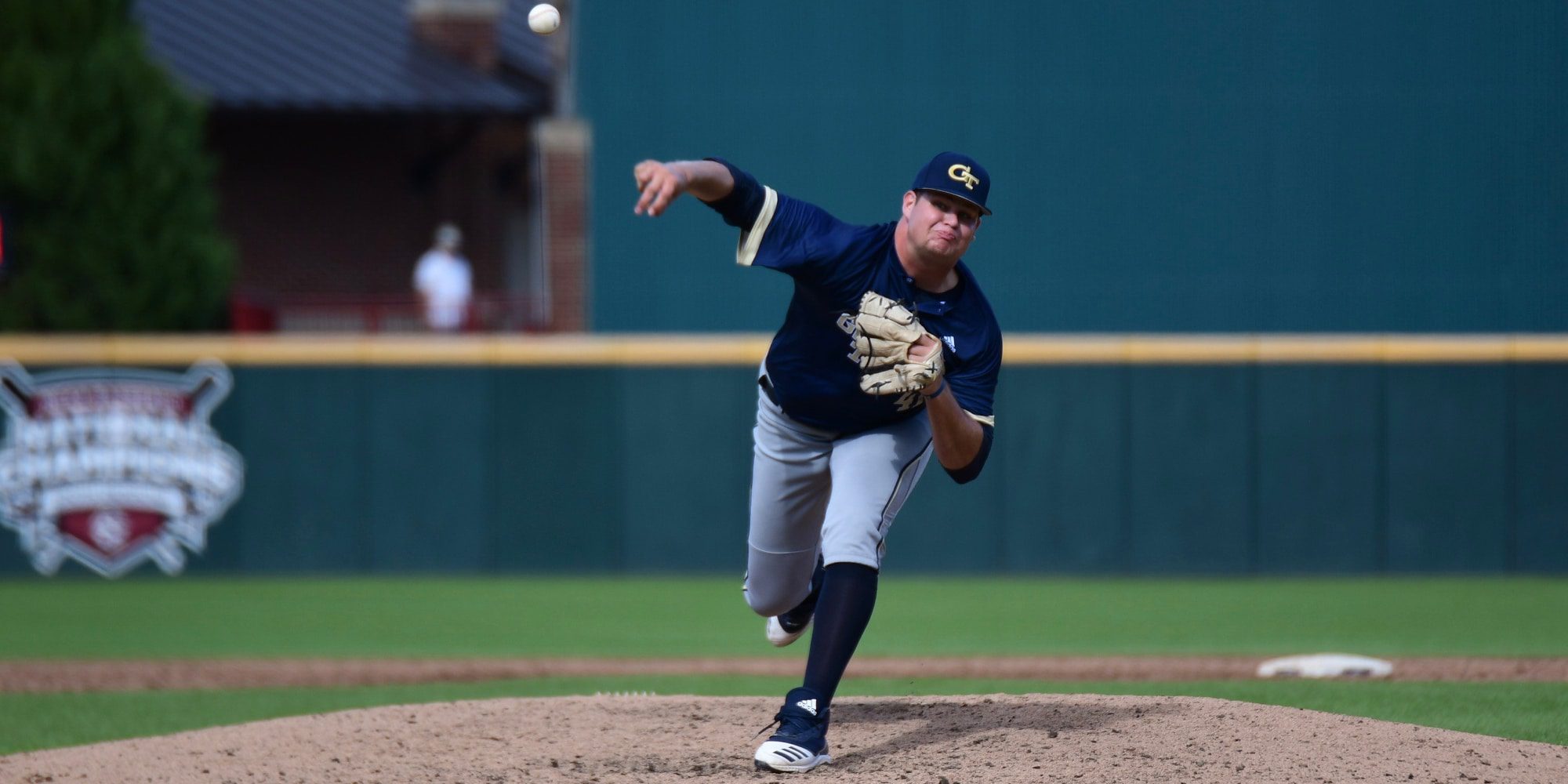You are using an out of date browser. It may not display this or other websites correctly.
You should upgrade or use an alternative browser.
You should upgrade or use an alternative browser.
2020 D1 Baseball GT #14 (up from 2019 end of season #42)
- Thread starter eokerholm
- Start date
Deleted member 2897
Guest
Sorry, I tried to go back in and edit....
2019 Recruiting Class .... Aren't they a little late?
D1 = #14
2019
PG = #5 (but with 19 in the class)
2020?
PG = #19 (with 13 in the class)
Yes, Fake Baseball News LOL
BobbyA
Georgia Tech Fan
- Messages
- 7
here you go:
14. Georgia Tech

Recruiting Coordinator: James Ramsey.
Overview: The Yellow Jackets had some big shoes to fill in their lineup after losing All-Americans Kyle McCann and Tristin English, and their all-freshmen recruiting class provided instant replacements in the heart of the order, along with a couple of athletic up-the-middle building blocks and a quartet of pitchers who should help right away. This is one of those classes that boosted its stock through its strong showing in fall ball, as several key recruits here looked far better than their high school rankings reflected.
The Stars: Drew Compton (136) looks like the next in a long line of great Georgia Tech sluggers. A 6-foot-2, 205-pound switch-hitter, Compton has a quiet setup, an advanced feel for his barrel, and legitimate plus power from both sides of the plate, with the ability to drive the ball to all fields. Expect him to be a fixture at first base (where he’s a good defender) and in the heart of the Tech order for the next three years. Catcher Andrew Jenkins (97) is a strong-bodied 6-foot, 205-pound righthanded hitter who seems likely to serve as the primary DH this spring, as he’s still a work in progress behind the plate (where his arm strength is an asset). He hit in the 5-hole right behind cleanup man Compton in a fall scrimmage at South Carolina, a sneak preview of how the Jackets are likely to structure their lineup next spring. The Yellow Jackets don’t need to rush Jenkins’ defensive development because they also have Jake Holland (367), a more experienced and advanced backstop who has impressed the coaches and the pitchers with his ability to handle a staff, receive and block. He’s flashed some power at the plate, and coach Danny Hall compares him physically to former Georgia Tech star and No. 2 overall pick Joey Bart at the same age.
The blue-chipper on the mound is RHP Zach Maxwell (142), a 6-foot-6, 245-pound lumberjack with premium arm strength and a clean high three-quarters arm action. He sat comfortably at 94-96 and bumped 97 in Columbia, and his fastball also has a good spin rate in the 2400-2500 range, making it tough to square up, especially up in the zone. His power slider at 82-85 was a bit inconsistent, but it flashed obvious wipeout potential, with a spin rate as high as 2800 rpm. His changeup and his command remain works in progress, but he has a chance to dominate with his fastball and slider, either as a starter or in the late innings.
 Georgia Tech fireballer Zach Maxwell (Aaron Fitt)
Georgia Tech fireballer Zach Maxwell (Aaron Fitt)
The Sleepers: Tres Gonzalez (144) showed plus speed from home to first that also translated to excellent range in center field. He’s a wiry 6-foot, 165-pound lefthanded hitter who showed good plate discipline and has the look of a future leadoff man for the Jackets, though he might have to wait his turn because Tech brings back a lot of experience in the outfield. Fellow quick-twitch athlete Jadyn Jackson should be a valuable utilityman who played lights-out defense at shortstop and second base this fall. He has good hands and range, an accurate arm and a quick release, and he’s also surprised the Jackets with his ability to handle the bat this fall.
The Yellow Jackets will count on additional talented freshmen to bolster their bullpen depth. Righthander Jackson Finley (256) was 92-94 at South Carolina and flashed a promising curveball at 76-78, but his command of his fastball and breaker have room to improve. Lefty Dalton Smith attacked at 88-90 from a short, quick three-quarters arm action and showed a very good tumbling changeup at 80-81. Fellow lefty Josiah Siegel carved at 86-87 with good angle from a three-quarters slot, and his 79-80 slider should be a nice second pitch for him. Jackson Arnold (415) and Brody Westbrooks can both bump the low 90s and spin effective breaking balls; Arnold also has a developing changeup, and Westbrooks stands out for his high-spin-rate fastball, which makes his fastball tough to square up when it’s elevated.
—Aaron Fitt
14. Georgia Tech

Recruiting Coordinator: James Ramsey.
Overview: The Yellow Jackets had some big shoes to fill in their lineup after losing All-Americans Kyle McCann and Tristin English, and their all-freshmen recruiting class provided instant replacements in the heart of the order, along with a couple of athletic up-the-middle building blocks and a quartet of pitchers who should help right away. This is one of those classes that boosted its stock through its strong showing in fall ball, as several key recruits here looked far better than their high school rankings reflected.
The Stars: Drew Compton (136) looks like the next in a long line of great Georgia Tech sluggers. A 6-foot-2, 205-pound switch-hitter, Compton has a quiet setup, an advanced feel for his barrel, and legitimate plus power from both sides of the plate, with the ability to drive the ball to all fields. Expect him to be a fixture at first base (where he’s a good defender) and in the heart of the Tech order for the next three years. Catcher Andrew Jenkins (97) is a strong-bodied 6-foot, 205-pound righthanded hitter who seems likely to serve as the primary DH this spring, as he’s still a work in progress behind the plate (where his arm strength is an asset). He hit in the 5-hole right behind cleanup man Compton in a fall scrimmage at South Carolina, a sneak preview of how the Jackets are likely to structure their lineup next spring. The Yellow Jackets don’t need to rush Jenkins’ defensive development because they also have Jake Holland (367), a more experienced and advanced backstop who has impressed the coaches and the pitchers with his ability to handle a staff, receive and block. He’s flashed some power at the plate, and coach Danny Hall compares him physically to former Georgia Tech star and No. 2 overall pick Joey Bart at the same age.
The blue-chipper on the mound is RHP Zach Maxwell (142), a 6-foot-6, 245-pound lumberjack with premium arm strength and a clean high three-quarters arm action. He sat comfortably at 94-96 and bumped 97 in Columbia, and his fastball also has a good spin rate in the 2400-2500 range, making it tough to square up, especially up in the zone. His power slider at 82-85 was a bit inconsistent, but it flashed obvious wipeout potential, with a spin rate as high as 2800 rpm. His changeup and his command remain works in progress, but he has a chance to dominate with his fastball and slider, either as a starter or in the late innings.

The Sleepers: Tres Gonzalez (144) showed plus speed from home to first that also translated to excellent range in center field. He’s a wiry 6-foot, 165-pound lefthanded hitter who showed good plate discipline and has the look of a future leadoff man for the Jackets, though he might have to wait his turn because Tech brings back a lot of experience in the outfield. Fellow quick-twitch athlete Jadyn Jackson should be a valuable utilityman who played lights-out defense at shortstop and second base this fall. He has good hands and range, an accurate arm and a quick release, and he’s also surprised the Jackets with his ability to handle the bat this fall.
The Yellow Jackets will count on additional talented freshmen to bolster their bullpen depth. Righthander Jackson Finley (256) was 92-94 at South Carolina and flashed a promising curveball at 76-78, but his command of his fastball and breaker have room to improve. Lefty Dalton Smith attacked at 88-90 from a short, quick three-quarters arm action and showed a very good tumbling changeup at 80-81. Fellow lefty Josiah Siegel carved at 86-87 with good angle from a three-quarters slot, and his 79-80 slider should be a nice second pitch for him. Jackson Arnold (415) and Brody Westbrooks can both bump the low 90s and spin effective breaking balls; Arnold also has a developing changeup, and Westbrooks stands out for his high-spin-rate fastball, which makes his fastball tough to square up when it’s elevated.
—Aaron Fitt
eokerholm
Helluva Engineer
- Messages
- 1,592
NOICE!! Great article. Found ACCN on Uverse and will upgrade this spring to watch!
We'll be in ATL in July before WWBA and will visit the coaches/campus.
Can't wait for summer ball (for my son) and Spring Season for GT!!!!
https://media.giphy.com/media/3o7TKNthed4OG7T5Je/giphy.gif
We'll be in ATL in July before WWBA and will visit the coaches/campus.
Can't wait for summer ball (for my son) and Spring Season for GT!!!!
https://media.giphy.com/media/3o7TKNthed4OG7T5Je/giphy.gif
